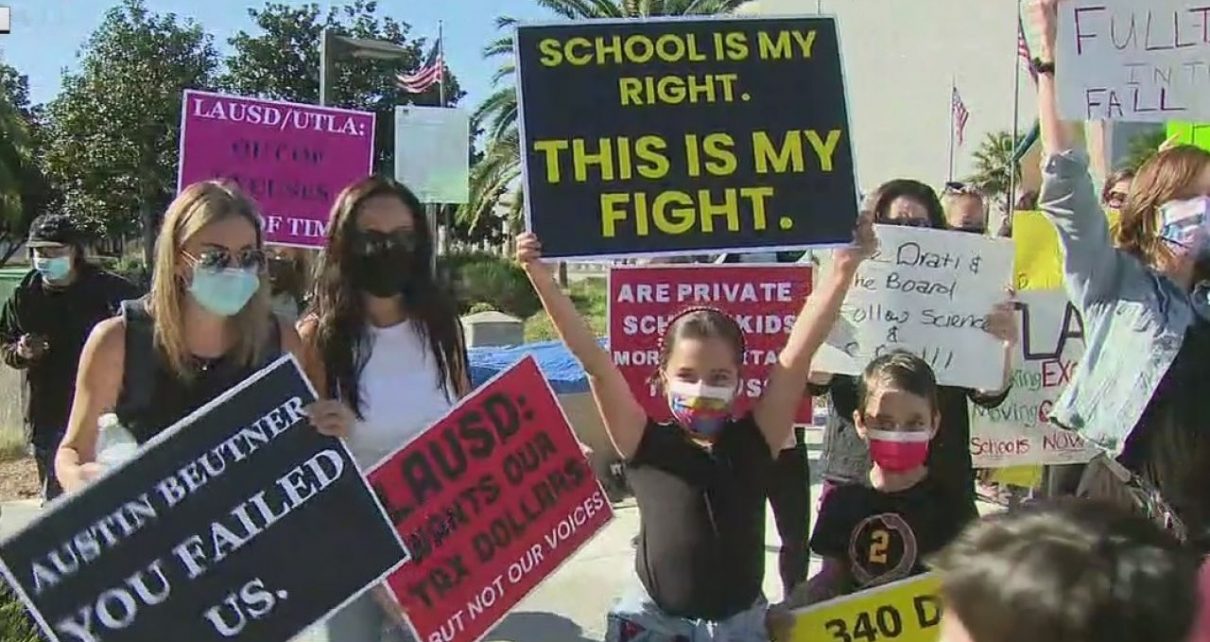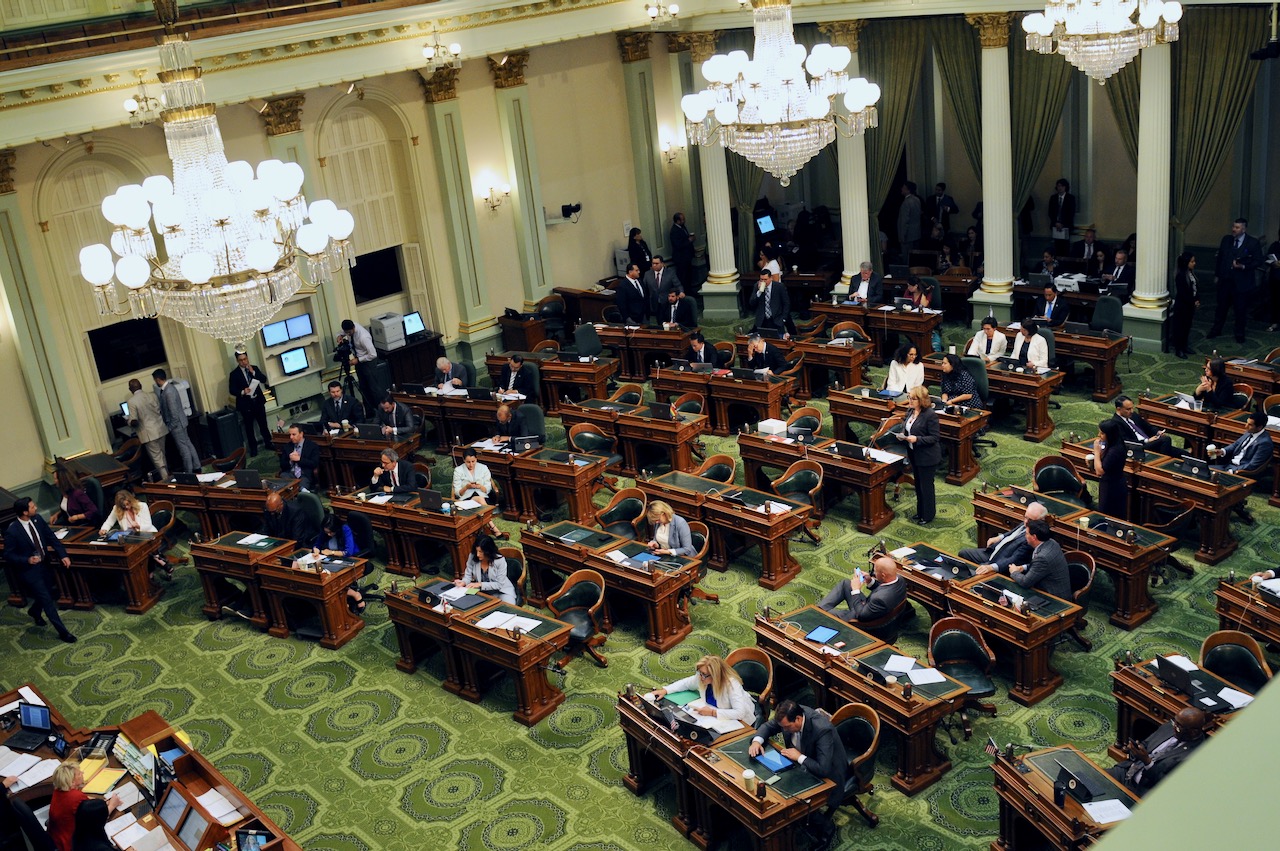
LA "Zoom blackout" school reopening protests on February 2, 2021 (Photo: screen capture Youtube)
Fixing K-12 Education in California
More parents than ever have now witnessed the selfish overreach of the teachers’ unions
By Edward Ring, April 7, 2021 6:07 am
Supporters of education reform in California have never had a bigger opportunity than right now. More parents than ever have now witnessed the selfish overreach of the teachers’ unions, at the same time as they’ve experienced, by the millions, creative educational solutions that bypass the traditional public school system. At the same time, an activist army has been formed in California that has already logged one major victory – collecting 2.1 million signatures to force Governor Newsom to defend his record in a special recall election – and they are looking for new battles to fight. When it comes to fixing education in California, here are some battles that need to be fought.
Universal Education Savings Accounts: The reform that would change everything are universal Education Savings Accounts, where the money follows individual students to whatever K-12 school their parents choose for them: traditional public school, charter school, parochial school, private school, or even charter/homeschool and private/homeschool hybrids.
Unchaining the torrent of money that currently pours into traditional public schools without competition and with minimal accountability would be an unprecedented breakthrough. Many of the details of how this could be done have been worked out in SB 1344, introduced by then State Senator Moorlach in 2018. It would allocate education funds mandated under Prop. 98 into education savings accounts, assigning an equal amount for every K-12 student in California. Currently that is about $12,500 per student per year.
A group in California already working on adapting SB 1344 to become an initiative constitutional amendment to be qualified for the November 2022 ballot is the California School Choice Foundation, ran by Pasadena attorney Michael Alexander. Potentially joining Alexander’s group in this effort are people who volunteered on the Newsom Recall campaign, forming the nucleus of what could become a grassroots movement of extraordinary power. But reformers should be aware of the other approaches to fixing public education in California.
Empower Charter Schools: One of the biggest alternative ways to start fixing education in California is to empower charter schools. This could be accomplished by broadening the list of entities that can authorize charter schools, permitting charters denied initial opening or renewal applications to appeal to any authorizing entity, taking away the cap on how many charter schools can be opened, and prohibiting denial of charter applications or renewals for reasons such as the alleged negative financial impact they may have on traditional public school budgets.
These are big ideas, but there’s much more.
Limit Union Negotiations to Pay and Benefits / Outlaw Strikes: Equally big and disruptive and beneficial to public education in California would be to roll back the prerogatives of the teachers’ unions. Currently, to quote a well informed, very indignant reformer who prefers anonymity at this time, “these unions can control what color chalk you are allowed to use on the blackboard.” More to the point, the teachers’ unions include in their bargaining negotiations things that ought to be up to the district superintendents and the elected school board, such as what textbooks to use. A reform that could go a long way towards fixing public education would be to simply rewrite the education code so unions negotiate over wages and benefits, and nothing more. At the same time, take away their right to strike. Defang the unions.
Change Rules Governing Tenure, Layoffs, and Dismissal: Another reform, certain to attract bitter opposition from the teachers’ unions but not so explicitly and overtly targeting them would be to simply change some of the work rules. The Vergara case of 2016, which unfortunately failed in the California Supreme Court on a technicality, provides a roadmap. Lengthen a teacher’s probationary period before acquiring tenure to at least five years. Replace seniority with merit as the criteria governing which teachers to retain and which to let go in layoffs and downsizings. And greatly streamline the ability to fire incompetent or negligent teachers, so principals can hold them accountable, rewarding good teachers and terminating bad teachers.
Empower Parents to Opt-Out of Politicized Instruction: Not least, a major reform would be to empower parents to remove students from classes that the parents feel violate their beliefs and principles. The new sex education classes, which many parents feel are both inappropriately graphic and tinged with an agenda, are an obvious example, but there are others. Politicized curricula that teaches students according to the controversial 1619 Project, or critical race theory, are other examples. If it were properly formulated, a parent empowerment initiative could be successful. It would allow parents to prevent the indoctrination of their children.
Many of the experts around the nation that have been contacted for education reform ideas are against wholesale, sweeping changes. But in almost every case, these are activists and lobbyists who worked with legislatures to enact reform. In those situations, the legislature may not have had a sufficient majority of staunch reform advocates to support dramatic changes. Incrementalism was the only possible way forward.
California is a different case. California’s Legislature will never enact reforms. Pro-charter and pro-school-choice advocates in California’s legislature are so outgunned that their mission is merely to reduce the speed at which the teachers’ union accomplishes their always expanding agenda.
For this reason, the only thing that should matter to education reformers in California is what voters think. California’s ballot initiative process is the one final safety valve preventing a complete takeover of the state government by special interests.
Proponents of universal education savings accounts face objections from battle weary reformers who’ve tried it before. Their argument goes something like this: If you try to take on the teachers’ union, they will spend you into the ground, you will lose badly, and nobody will want to try it again for another twenty years. Do a little bit at a time, log some small victories, and gradually move towards bigger reforms.
The problem with that argument ought to be obvious. The teachers’ union will spend you into the ground whether you’re going for a big reform or a small reform. The question, and the only question, should be what are voters willing to support. Universal education savings accounts help everybody. Incremental reforms do not help everybody. By definition, broader reforms ought to have broader appeal.
The opportunity posed by the shameful behavior of the teachers’ unions during the pandemic, combined with the presence for the first time of powerful and effective statewide grassroots groups, can still be lost. Proponents should make something very clear: We are going to put this on the ballot in 2022, and if we fail, we’re going to put it on the ballot again in 2024, and again if necessary in 2026 and so on. And the way to accomplish this is to budget accordingly.
With the right combination of grassroots support and state-of-the-art outreach, the cost of getting an initiative on the ballot has come down for the first time in years. To qualify a statewide initiative, plan on spending $5 million in 2022, then again in 2024, and again in 2026. Separate the organizational and financial effort to qualify from the resulting independently ran campaigns that will spring up in support, because those campaigns cannot be controlled. Plan on a six year effort. Drain the unions dry. By 2026, if not sooner, they’ll be broke.
For an expenditure of $15 million over six years, the unions will spend at least $150 million. That alone makes this a compelling case. With an aggressive, creative, honest campaign that doesn’t pussyfoot around these unions, however, a universal education savings account measure will be approved by voters, meaning the teachers’ union will not only be financially broken, but their monopoly on our children’s futures will also be broken.
- Ringside: Saving California’s Rural Water Users - May 8, 2025
- Ringside: How to Add 10 Million Acre Feet Per Year to California’s Water Supply - April 30, 2025
- Ringside: Can EVs Make Up for Gasoline Shortages? - April 23, 2025








All of the above, please….
Whatever it takes to “defang the union”…
They were leftard idiots in the 70’s when I was in LAUSD – I cannot even IMAGINE what it’s like now…
Like California, Hawaii is a deep blue state. But that was NOT always the case. When I did my dissertation at Stanford (1988), there was parity between private and public schools; a symbiotic relationship. At that time, Hawaii had the highest per capita PRIVATE school enrollment of any state. Many parents sent their children to BOTH public and private K-12 school because quality was not a big issue; both were high quality. There was, in effect, de facto CHOICE. This kind of BALANCE in academic quality is possible accomplish; but the power of the teachers’ union must be mitigated somehow. If this can be done, the enrollment in private schools will increase and public schools will be forced to improve to a point where there is parity with private schools, IMO. Ask Michael Kirst, Ed Haertel.
We obviously can’t count on the teachers’ unions or most of local school boards to put our kids first when making decisions about education. Parents need to be able to make choices that are in the best interests of their children. The timing is right to push school choice and put the unions on the defensive.
John, yes. Parents for the most part want to do what is best for their children. Some children do better in a public school setting and some do better in a private school. My anecdotal observations in Hawaii was that the middle school was being used by parents as the “try out” period. If the child did better or preferred to learn in a private or public school, this was when the switch was made for grades 9-12. Food for thought. But the SYSTEM is what would allow for that to happen.
I agree, John.
Another aspect for reforming education to consider is an examination of how prospective teachers are screened and trained in credential programs.
Slightly off topic but another issue is the use of education vouchers. My problem with vouchers is that they lead to price inflation without necessarily leading to improved quality. For example, housing rent vouchers. Again using Hawaii as an example, military families are provided with vouchers for off-base rental housing. So, landlords being aware of the amount, raise their rents to an amount corresponding to the vouchers; regardless of whether the rental is high or low quality. A nice apartment is the same high cost as a junky one (although some cosmetic improvements are usually made). This also can lead to social animosity between civilians (locals) who must also pay the higher prices and the military families. More food for thought.
:Have parents ever tried suing a school district in civil court to recoup kids tuition to a private school? It shouldn’t be difficult to prove where the better education is, especially after this last year. If this were a private business you paid for services not rendered you would sue to get money, why can’t it apply here? Parents shouldn’t be forced to settle for a subpar education for their children. Would this be the case if California were not under a one party rule?
Jeffrey, I feel your pain. Most parents don’t have the time, money or knowledge to fight the system. And some are just intimidated. I met a Hispanic woman once; we saw a traffic accident happen. I said, “You can be a witness.” She said, “No, where I came from if you are a witness, you will be disappeared.” However, I do believe that parents need to get involved in local school board meetings/elections and take control from political operators who are backed by the teachers’ union. California has to become a two party system again.
Comrades
Who are home eating macaroons and chocolate truffles?
And getting paid handsomely while you’re stocking grocery shelves or directional waving Covid vaccine seekers at public venues…..we are as named: CHUMPS